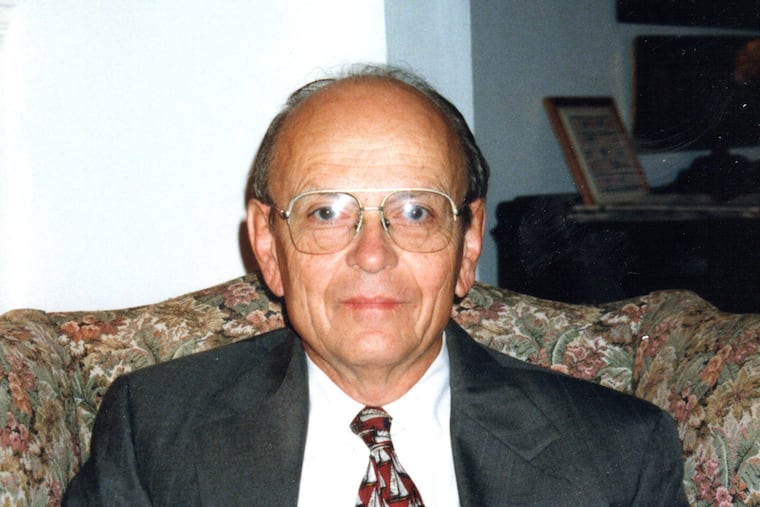John A. Dawson, an adventurer and scientist whose research took him to the South Pole, dies at 85
Dr. Dawson began his scientific research in a dark, frozen outpost in Antarctica. He had to chip ice from the corners of his quarters, and melt snow for drinking water.

John Alexander Dawson, 85, of Bala Cynwyd, a lifelong adventurer, transportation planner, and scientist whose early research took him to a frozen outpost in Antarctica, died Friday, Dec. 11, of pneumonia at Lankenau Medical Center.
Dr. Dawson was born to George and Carolyn Dawson in South Amboy, N.J. He graduated from Highland Park High School and Rutgers University with a bachelor’s degree in physics.
He earned a master of science degree from Lehigh University and a Ph.D. from the Geophysical Institute of the University of Alaska Fairbanks. His thesis was on geomagnetic micropulsations, or fluctuations in the Earth’s magnetic field caused by variations in solar wind.
His first job was as a scientist observing the aurora australis, the southern cousin to the aurora borealis, at the Amundsen-Scott South Pole Station in 1957 and 1958. Just being there demanded toughness: As winter approached, a two-day twilight yielded to six months of continuous darkness.
It was so cold in the rudimentary buildings that Dr. Dawson had to chip ice from the corners of his quarters. The scientists also shoveled snow to melt for drinking and bathing.
Dr. Dawson met the explorers Sir Edmund Hillary and Sir Vivian Fuchs at the South Pole base. Hillary and Sherpa Tenzing Norgay were the first confirmed climbers to summit Mount Everest. Fuchs’ expeditionary team completed the first overland crossing of Antarctica in 1958.
Later, the Advisory Committee on Antarctic Names named a 6,800-foot mountain in the Queen Elizabeth Range after Dr. Dawson. It’s now known as Dawson Peak, to mark his contributions to the understanding of the aurora australis through his work at the South Pole Station.
In the early 1960s, Dr. Dawson and a friend kayaked down the Alsek River, which flows from Yukon into Northern British Columbia in Canada, and to Alaska, entering the Gulf of Alaska at Dry Bay. They are believed to be the first Westerners to traverse the full course of the 240-mile river, through uncharted wilderness.
“At the end of their journey, they spotted a fishing cabin near Dry Bay,” his family said in a statement. “They knocked at the door and startled the inhabitant, who said that in his two decades spending summers there, no one had ever knocked at his door before.”
Starting in 1963, Dr. Dawson was a scientist at a U.S. Commerce Department laboratory in Boulder, Colo.
From 1966 to 1972, he taught physics at Ahmadu Bello University in Zaria, Nigeria. While based there, he traveled throughout Africa and Europe. He and his wife, Margaret McLaren Dawson, whom he married in 1966, climbed Mount Cameroon, the highest point in sub-Saharan western Africa.
From 1973 to 1978, he worked as a scientist at the Naval Research Laboratory in Washington. From 1978 to 1985, he was a consultant with R.L. Banks & Associates, a firm in Arlington, Va., specializing in the economics of transportation.
From 1985 until his retirement in 2001, Dr. Dawson was a transportation planner for the Delaware Valley Regional Planning Commission. He prepared for the job by earning an M.B.A. from American University.
He planned some of the early routes for the Philly PHLASH, a downtown loop designed to take visitors to the sights of Philadelphia.
During free time, he traveled every Amtrak route in the United States and across Canada by rail. In 2009, the Dawsons retraced the path of the Lewis and Clark Expedition across America. The historic expedition, during which the explorers sought an overland passage to the Pacific Ocean, spanned the years 1804 to 1806.
Dr. Dawson made many voyages, first on his sailboat, and later on his trawler. Both were named Aurora.
Dr. Dawson served on the board of Delaware Valley Association of Rail Passengers. He was a member of the Rutgers Alumni Association and the Antarctican Society.
He cooked the featured recipe in the Sunday New York Times each week and took his wife to the movies on Wednesdays. He was always planning trips, helping others plan trips, working for the Democratic Party, or watching college basketball on TV.
He was blessed with a curiosity that knew no bounds. “He could talk about any topic, but never bragged,” his family said in a statement.
In addition to his wife, he is survived by sons David and Robert Dawson, five grandchildren, two brothers, and a sister.
Interment will be private. Services will be held once the coronavirus pandemic ebbs.
Memorial donations may be made to the Delaware Valley Association of Rail Passengers, 1635 Market St., Suite 1600, Philadelphia, Pa. 19103, or the Cancer Support Community of Greater Philadelphia, 200 Kirk Rd., Warminster, Pa. 18974.